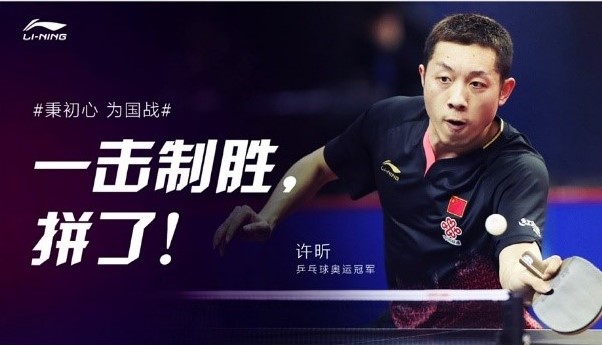

What do these two pictures have in common?
Table tennis and Ai-chan, right!
So the question you probably have now is…
WHY TABLE TENNIS?
Table tennis is one the fastest racquet sports in the world and the response time towards the ball is one of the shortest as well. Table tennis is a sport that requires exceptional levels of alertness and reaction, while at the same time so much tactical skills, creativity, focus, inner drive, competitiveness, self-discipline is needed in order to succeed. Table tennis is a sport where the word “unpredictable” jumps at you at almost every side of the table. The dynamics of the sport are constantly changing and the skillsets required to up the game are always on the move, which makes it extremely difficult to survive in such environments. There are currently more than 164 million active players and about 250 million amateur players worldwide.
The reason why I introduce table tennis is to examine how marketing communications has changed from being a tool for sports diplomacy 50 years ago, to having great potential in becoming an important means of advertising now, specifically in Asia.
AS SPORTS DIPLOMATS – HERE’S WHAT HAPPENED.
Table tennis was first used in the 1970s as a means to improve the United States-China relations, dubbed as the “Ping-Pong Diplomacy.” This was the first time that a US delegation was allowed into Beijing since the Communist party took over in 1949. The purpose of using table tennis to improve the US-Sino relations was to move away from using Cold War propaganda and to build something together looking towards the future. In 1971, the American table tennis team was invited for an all-expense paid trip to China at the 31st World Table Tennis Championships in Japan. Table tennis was a great example of the utilization of soft power, which is a persuasive approach to international relations, usually through economic and cultural influence.
TABLE TENNIS FACES IN ADVERTISEMENTS.
First things first, a celebrity athlete endorser is a “publicly recognised sports star which uses that public recognition to help another bolster the image of or sell specific goods and services” (Charbonneau, 2006).
Table tennis athletes are chosen on the basis that there can be enhanced consumer recognition and brand awareness to drive sales and have positive influence on the brand. Usually, most athletes that are selected are top ranked in the world, are physically attractive or are able to portray a sense of likeability and trustworthiness for the brand. The importance should be placed on the degree of perceived fit with the brand or product and the table tennis athlete. Therefore, while deciding if the specific table tennis player is suitable for the brand, there are three frameworks that can be applied before making a decision:
The first framework is the model of athlete brand image (MABI). There are three areas that need to be evaluated:
1. Athletic performance
2. Attractive appearance
3. Marketable lifestyle
The second framework is the TOPSTAR approach, which stands for:
1. Team
2. Off-field
3. Physical characteristics
4. Success
5. Transferability
6. Age
7. Reputation
The third framework focuses on the athlete as a form of a message source where six different aspects need to be examined:
1. Attention
2. Attitude towards the advertisement
3. Trustworthiness
4. Expertise
5. Aspirational Aspects
6. Meaning Transfer
To put things into context, let’s take a look at a few examples. The advertisements that are shown below check the boxes for either framework, which makes the athlete a successful choice for the brand.


For those who are not as familiar with table tennis, Fukuhara Ai (as shown in both examples) was one of the top ranked table tennis players in the world, winning a silver medal in the 2012 Olympics and a bronze medal in the 2016 Olympics with the Japanese national table tennis team. Although she has now retired, she still is the top choice for brands, especially within the Japanese and Taiwanese market. Her husband Chiang Hung Chieh (as shown in the picture on the left) is a national table tennis player from Taiwan.
Regarding the MABI framework, both Ai-chan and her husband are the cream of the crop in the table tennis industry and are deemed as two of the best looking athletes not only in the industry, but also across their respective national team representatives (Japan and Taiwan) in all sports. Recently, the pair participated in a Chinese variety show which promoted their happy family lifestyle, which led to a lot of viewers dubbing them as the “dream couple.” This also checks the third box of having a marketable lifestyle, so that the brand is able to use this for the audience to make associations with the ability of having such lifestyle. The picture of the left illustrates a picture of her and her husband being very happy with the baby and exactly depicts this image, which is correlated with the Panasonic air-conditioner that is being marketed.
This is also the same for other table tennis players from other countries in Asia, namely Yang Ha Eun from South Korea, Isabelle Li from Singapore and Xu Xin from China, where they are top-ranked in the world and are players, who citizens of the nation look up to, making them a good choice as a table tennis athlete endorser.



Also, from all the examples, it is evident that the potential of using table tennis athletes as endorsers in a marketing campaigns extends way beyond table tennis apparel brands. The brands that are presented here include:
- Panasonic, a consumer electronics company from Japan
- ANA, the largest airline in Japan
- Shinhan Bank, one of the largest banks in South Korea
- Milo, a beverage company prominent in Asia, Oceania, South America and parts of Africa
- Li-Ning, a sports apparel brand from China
There is so much potential for table tennis athletes to reach into the world stage in terms of being an integral part of marketing communications for a brand and I look forward to seeing more brands reach out to table tennis athletes to work on different types and levels of collaborations in the future!
References
Antonovica, A., & Curiel, J. (2016). Sport celebrities multiple use in marketing messages: Example of the Spanish tennis player Rafael Nadal. Marketing and Branding Research, 3, 179-193.
Can ping-pong boost China’s soft power? (2010). Top Spin – Week In China, WiC 83.
Carter, T. F., & Sugden, J. (2011). The USA and Sporting Diplomacy: Comparing and Contrasting the Cases of Table Tennis with China and Baseball with Cuba in the 1970s. International Relations, 26(1), 101-121.
Charbonneau, J. (2006). The use of celebrity athletes as endorsers: Views of the New Zealand general public. International Journal of Sports Marketing and Sponsorship, 326-333.
Desmarais, F. (2017). Who is the Athlete Endorser? A Cross-Cultural Exploration of Advertising Practitioners’ Views. Journal of Global Marketing, 30(1), 12-30.
Ha, L. (1997). Limitations and Strengths of Pan-Asian Advertising Media: A Review for International Advertisers. International Journal of Advertising, 16, 148-163.
Kahle, L. R., & Homer, P. M. (1985). Physical Attractiveness of the Celebrity Endorser: A Social Adaptation Perspective. The Journal of Consumer Research, 11(4), 954-961.
Kim, K. (2008). The effect of sports involvement, sponsor awareness, and corporate image on intention to purchase sponsors’ products. International Journal of Sports Marketing and Sponsorship, 79-94.
Knoll, J., & Matthes, J. (2017). The effectiveness of celebrity endorsements: A meta-analysis. Journal of the Academy of Marketing Science, 45, 55-75.
Schubert, M., & Seyffert, J. (2017). Fan motives for interacting on social media – the example of the International Table Tennis Federation and Facebook. Current Issues in Sports Science, 2, 1-11.
Shuart, J. (2007). Heroes in Sport: Assessing Celebrity Endorser Effectiveness. International Journal of Sports Marketing & Sponsorship, 126-140.
Sports Diplomacy as a ‘Soft Power’ tool. (2014). Public Diplomacy and Global Communication.
Tsai, H. (2004). A study on the sponsorship strategy of athletes endorsement. A sponsorship case study of nu skin enterprise with table tennis player jing chen. Centro Esportivo Virtual.
Wang, B., Guo, W., & Zhou, C. (2016). Selective enhancement of attentional networks in college table tennis athletes: A preliminary investigation. PeerJ, 1-12.

3 Responses to Table Tennis Athletes: Advertising Beyond Public Diplomacy